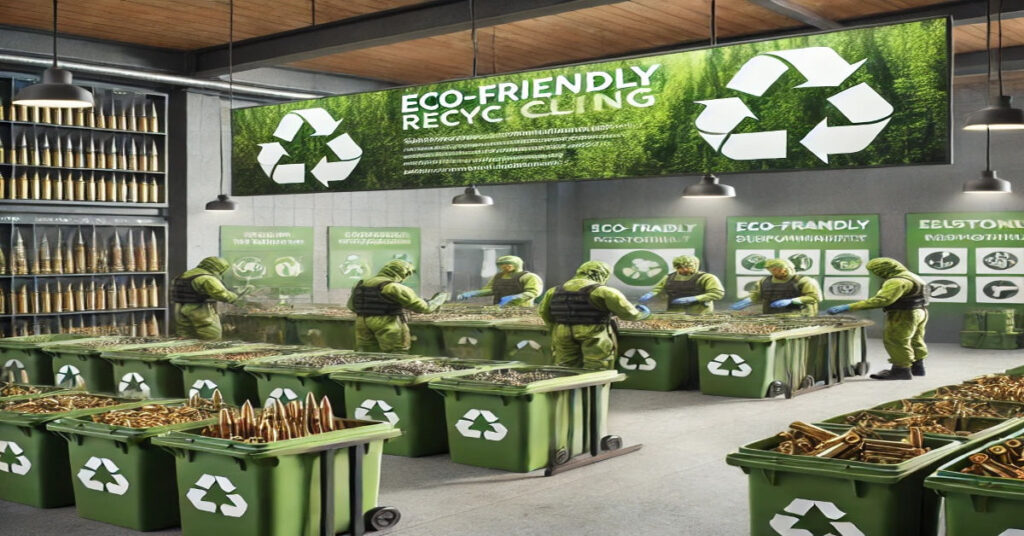Recycling is an essential practice for reducing waste and protecting the environment, but did you know that scrap ammunition can also be recycled? From spent brass casings to damaged or unused live rounds properly handling and Recycle Scrap Ammo is not only environmentally responsible but can also be a profitable venture.
In this article, we’ll explore the ins and outs of recycling scrap ammo, including its benefits, the types of ammunition that can be recycled, and practical steps for safely handling and disposing of scrap ammo. Whether you’re a gun enthusiast, a shooting range operator, or someone curious about eco-friendly practices, this guide provides everything you need to know.
Why Recycle Scrap Ammo?
Environmental Benefits
Millions of rounds of ammunition are fired every year, producing a significant amount of waste in the form of brass casings, duds, and other components. Recycling these materials prevents them from ending up in landfills, where they could pose risks to the environment.
- Reduce Hazardous Waste: Ammunition contains metals and chemicals that can leach into soil and water, causing contamination.
- Preserve Resources: Recycling brass, lead, and steel reduces the need for mining new materials, conserving natural resources.
Financial Advantages
Recycling scrap ammo can be surprisingly profitable. Brass casings, for example, are highly recyclable and have considerable value in the scrap metal market. Shooting ranges and individuals can earn extra income by collecting and recycling spent shells.
Types of Scrap Ammo That Can Be Recycled
Spent Brass Casings
These are the empty shells left behind after firing a round. Brass casings are the most commonly recycled ammunition component due to their high value and ease of recycling.
Duds (Unfired Rounds)
Duds are live rounds that fail to fire when triggered. They require special handling due to their potential to detonate.
Corroded or Damaged Ammo
Old or damaged ammunition that is no longer safe to use can still be recycled for its metal components.
Lead Bullets and Shot
Lead is a toxic material, making its proper disposal crucial. Recycled lead from bullets and shot can be repurposed for various industrial applications.
How to Safely Recycle Scrap Ammo
Recycling scrap ammo requires careful handling to ensure safety and compliance with legal regulations. Here’s a step-by-step guide:
Step 1: Sort Your Ammunition
Separate spent brass casings, duds, and other types of ammo to ensure proper recycling.
Step 2: Deactivate Live Ammo
For live rounds, contact a certified ammunition recycler or local law enforcement to safely deactivate the rounds before recycling.
Step 3: Clean Brass Casings
Spent casings can be cleaned using a brass tumbler to remove dirt and debris. Clean casings are more valuable and easier to recycle.
Step 4: Find a Recycling Facility
Locate a scrap metal recycler or specialized ammunition recycler in your area. Many shooting ranges also partner with recycling facilities.
Step 5: Follow Legal Guidelines
Ensure compliance with local laws regarding ammunition disposal. Some jurisdictions have strict regulations on handling and recycling live or spent ammunition.
Where to Recycle Scrap Ammo
Shooting Ranges
Many shooting ranges collect spent brass casings and partner with recycling facilities. Ask your local range if they have a recycling program.
Scrap Metal Recyclers
Scrap yards often accept brass casings and other metal components from ammunition. Call ahead to confirm they handle these materials.
Ammunition Manufacturers
Some manufacturers offer take-back programs for old or unused ammo, ensuring safe and responsible recycling.
Safety Tips for Handling Scrap Ammo
- Wear Protective Gear: Always use gloves and safety glasses when handling ammunition.
- Store Safely: Keep live rounds and duds in a secure, dry location away from heat sources.
- Avoid DIY Disposal: Never attempt to disassemble live ammunition yourself; always rely on professionals.
Common Uses for Recycled Ammo Materials
Recycled ammunition components can be repurposed in various ways:
- Brass Casings: Melted down to create new casings or other brass products.
- Lead Bullets: Used in manufacturing new bullets or industrial applications.
- Steel Casings: Repurposed for construction materials and tools.
How Recycling Scrap Ammo Supports Sustainability
Recycling scrap ammo not only reduces environmental harm but also supports sustainable practices in industries like construction, manufacturing, and ammunition production. By reusing valuable materials, we can minimize waste and conserve resources for future generations.
Challenges in Recycling Scrap Ammo
Legal Restrictions
Some regions have stringent regulations regarding ammunition recycling, particularly for live rounds. Always research local laws before proceeding.
Safety Concerns
Improper handling of duds or live ammo can pose serious risks. Working with certified professionals ensures safe recycling.
Lack of Awareness
Many people are unaware that ammunition can be recycled, leading to unnecessary waste. Promoting education and awareness is key to increasing recycling rates.
The Future of Scrap Ammo Recycling
As environmental concerns continue to grow, the recycling of scrap ammo is becoming more important. Innovations in recycling technology and increased awareness are expected to make the process safer, more efficient, and accessible to a wider audience.
Emerging Trends
- Automated Sorting Machines: These machines make it easier to separate recyclable materials from waste.
- Sustainable Ammo: Manufacturers are exploring eco-friendly materials to create ammunition that is easier to recycle.
- Community Programs: Increased collaboration between shooting ranges, recyclers, and local governments to promote recycling initiatives.
Conclusion
Recycling scrap ammo is not just a responsible choice—it’s a necessary one. By reducing hazardous waste, conserving resources, and supporting sustainability, recycling ammunition benefits both the environment and the economy. Whether you’re an individual shooter or a business owner, taking the time to recycle your scrap ammo can make a significant impact.
From spent brass casings to damaged rounds, there’s a proper way to handle and recycle every type of scrap ammo. By following safety guidelines and partnering with reputable recyclers, you can turn what might seem like waste into valuable resources. Start your journey toward responsible ammunition disposal today, and join the movement for a cleaner, greener future.
FAQs
1. Can I recycle live ammunition?
Yes, but live ammunition must be handled by professionals to ensure safety during recycling.
2. Where can I recycle spent brass casings?
Many shooting ranges and scrap metal recyclers accept brass casings for recycling.
3. Is it legal to recycle ammunition?
Recycling ammunition is legal in most areas, but specific regulations vary. Check your local laws.
4. Can I make money recycling scrap ammo?
Yes, brass casings and other recyclable components have value in the scrap metal market.
5. What should I do with duds or damaged rounds?
Contact a certified ammunition recycler or local law enforcement for safe disposal.
6. Are there eco-friendly alternatives to traditional ammo?
Some manufacturers are developing environmentally friendly ammunition with biodegradable or recyclable components.







